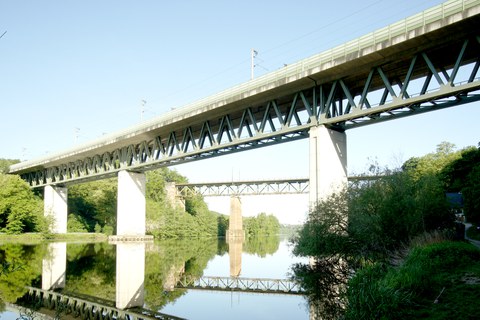Avoidance of rail expansion joints
Table of contents
Project data
| Titel | Title Wissenschaftliche Begleitung und Beratung zur Minimierung der Anzahl erforderlichen Schienenauszüge | Scientific support and advice to minimize the number of rail expansion joints Förderer | Funding DB Netz AG Zeitraum | Period 07/2020 – 12/2022 Leiter | Project manager Prof. Dr.-Ing. Steffen Marx Bearbeiter | Contributor Chongjie Kang, M. Sc. Projektpartner | Project partner Marx Krontal Partner GmbH, Hannover |
Report from year book 2020
Avoidance of rail expansion joints

Fuldatal bridge Kragenhof
The Hanover–Würzburg high-speed railway line, which went into full operation in 1991, is characterized by its special topography and 44 viaducts. The length of the structures ranges from 71 m to 1.628 m. After approximately 30 years of operation, the track systems will be renovated, in various stages (RA for short; staggered from 2019: RA1 to 2023: RA4).
For example, the 250 meter long Kragenhofer Bridge was built from 1986 to 1988. This steel composite truss bridge, carrying two railway tracks, was designed as a simply supported girder chain. Due to the very complex track/bridge interactions, six rail expansion joints were planned and constructed for this bridge. These rail expansion joints need to be maintained very intensively and regularly exchanged during the service life of the bridge. This is associated with high follow-up costs, and it disrupts the on-going traffic operation. To reduce the number of rail expansion joints as much as possible in the future, extensive investigations are to be carried out on the track/bridge interaction of the rails and the superstructures.
The engineering office Marx Krontal Partner (MKP)has carried out calculations to investigate the rail stresses due to track/bridge interaction by assuming that the rails on this bridge are continuously welded. Based on these calculations, the Institute of Concrete Structures will develop an optimization concept. To make the experience gained from the Kragenhofer Bridge beneficial for future standardization, a cross-project preparation, generalization, and documentation of the results are necessary. The requirements of rail expansion joints for the bridges, which are on the same railway section of the Kragenhofer Bridge, will be checked. To establish the feasibility of making an adequate proposal for different situations, the bridges with rail expansion joints on line 1733 would be examined. The corresponding experience gained from the maintenance work would be collected and systematically processed. In this project, a screening of the rail expansion joints on this section from kilometre position km 113.800 to km 264.930 will be carried out. Besides, information on the track system, special devices and superstructure of the bridges are to be collected and analyzed.
At the end of this project, an estimation of whether removal or at least optimization of the existing rail extensions will be provided for each bridge.
